初中英语句子成分及五种基本句型讲解与练习汇编
- 格式:doc
- 大小:52.00 KB
- 文档页数:7
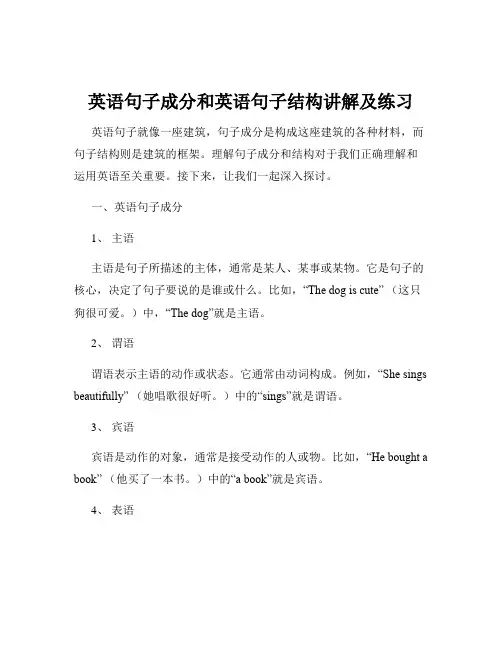
英语句子成分和英语句子结构讲解及练习英语句子就像一座建筑,句子成分是构成这座建筑的各种材料,而句子结构则是建筑的框架。
理解句子成分和结构对于我们正确理解和运用英语至关重要。
接下来,让我们一起深入探讨。
一、英语句子成分1、主语主语是句子所描述的主体,通常是某人、某事或某物。
它是句子的核心,决定了句子要说的是谁或什么。
比如,“The dog is cute” (这只狗很可爱。
)中,“The dog”就是主语。
2、谓语谓语表示主语的动作或状态。
它通常由动词构成。
例如,“She sings beautifully” (她唱歌很好听。
)中的“sings”就是谓语。
3、宾语宾语是动作的对象,通常是接受动作的人或物。
比如,“He bought a book” (他买了一本书。
)中的“a book”就是宾语。
4、表语表语用于说明主语的特征、状态、身份等。
常见的系动词有 be (am/is/are)、seem、look 等,其后的成分就是表语。
例如,“She is happy” (她很开心。
)中的“happy”就是表语。
5、定语定语用来修饰、限定名词或代词。
它可以是形容词、名词、代词、数词、介词短语等。
例如,“The red car is mine” (那辆红色的车是我的。
)中的“red”就是定语。
6、状语状语用于修饰动词、形容词、副词或整个句子,表示时间、地点、原因、方式、程度等。
比如,“He runs fast” (他跑得很快。
)中的“fast”就是状语。
7、补语补语用于补充说明宾语或主语的情况。
例如,“We made him our monitor” (我们选他当班长。
)中的“our monitor”就是宾语补足语。
二、英语句子结构1、简单句简单句只有一个主谓结构,是最基本的句子类型。
例如,“I love you” (我爱你。
)2、并列句并列句由两个或两个以上的简单句通过并列连词(and, but, or 等)连接而成。
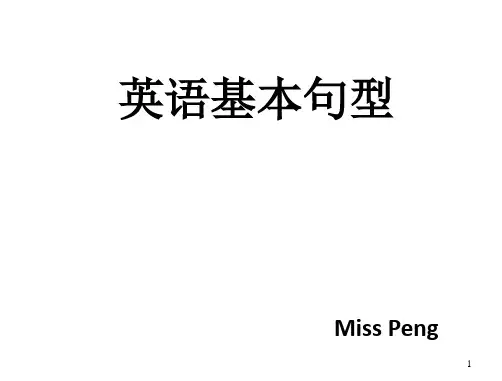
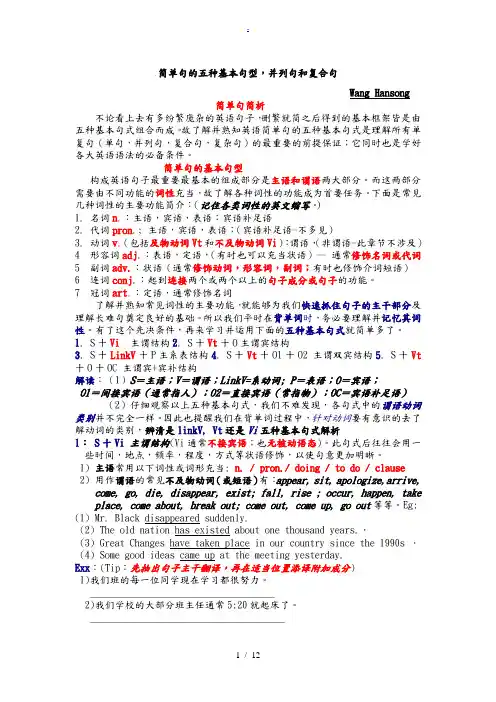
.简单句的五种基本句型,并列句和复合句Wang Hansong简单句简析不论看上去有多纷繁庞杂的英语句子,删繁就简之后得到的基本框架皆是由五种基本句式组合而成。
故了解并熟知英语简单句的五种基本句式是理解所有单复句(单句,并列句,复合句,复杂句)的最重要的前提保证;它同时也是学好各大英语语法的必备条件。
简单句的基本句型构成英语句子最重要最基本的组成部分是主语和谓语两大部分。
而这两部分需要由不同功能的词性充当,故了解各种词性的功能成为首要任务。
下面是常见几种词性的主要功能简介:(记住各类词性的英文缩写。
)1.名词n.:主语,宾语,表语;宾语补足语2.代词pron.; 主语,宾语,表语;(宾语补足语-不多见)3.动词v.(包括及物动词Vt和不及物动词Vi):谓语,(非谓语-此章节不涉及)4 形容词adj.:表语,定语,(有时也可以充当状语)-- 通常修饰名词或代词5 副词adv.:状语(通常修饰动词,形容词,副词;有时也修饰介词短语)6 连词conj.:起到连接两个或两个以上的句子成分或句子的功能。
7 冠词art.:定语,通常修饰名词了解并熟知常见词性的主要功能,就能够为我们快速抓住句子的主干部分及理解长难句奠定良好的基础。
所以我们平时在背单词时,务必要理解并记忆其词性。
有了这个先决条件,再来学习并运用下面的五种基本句式就简单多了。
1. S十Vi主谓结构2. S十Vt十O主谓宾结构3. S十LinkV十P主系表结构4. S十Vt十O1十O2 主谓双宾结构5. S十Vt 十O十OC 主谓宾+宾补结构解读:(1)S=主语;V=谓语;LinkV=系动词; P=表语;O=宾语;O1=间接宾语(通常指人);O2=直接宾语(常指物);OC=宾语补足语)(2)仔细观察以上五种基本句式,我们不难发现,各句式中的谓语动词类别并不完全一样。
因此也提醒我们在背单词过程中,针对动词要有意识的去了解动词的类别,辨清是linkV, Vt还是Vi五种基本句式解析1: S十Vi 主谓结构(Vi通常不接宾语;也无被动语态)。

初中英语句子成分讲解_练习及答案内部编号:(YUUT-TBBY-MMUT-URRUY-UOOY-DBUYI-0128)句子成分及基本句型一、考点、热点回顾【句子的成分】在英文中句子成分包括:主语、谓语、宾语(直接宾语、间接宾语)、表语、定语和状语、宾语补足语等。
(一)主语:主语是谓语讲述的对象,表示所说的“是什么”或“是谁”。
一般由名词、代词、不定式或相当于名词的词或短语来充当。
它在句首。
如:(1)Lucy is a beautiful nurse. (名词作主语)(2)He reads newspapers every day. (代词作主语)(3)Smoking is harmful to the health. (动名词作主语)(4)To swim in Kunming Lake is a great pleasure.(不定式作主语)(5)What we should do is not yet decided. (主语从句作主语)(二)谓语说明主语“做什么”“是什么”或“怎么样”。
谓语(谓语部分里主要的。
谓语和主语在人称和数两方面必须一致。
它在主语后面。
如:His parents are teachers. (系动词和表语一起作谓语)We study hard. (行为动词作谓语)We don’t finish reading the book. (助动词和行为动词一起作谓语)He can speak English. (情态动词和行为动词一起作谓语)(三)宾语宾语是动作、行为的对象,由名词、代词、不定式或相当于名词的词、短语来担任,它和及物动词一起说明主语做什么。
一般放在谓语之后。
She is doing her homework now.(名词作宾语)She says(that)she is ill.(宾语从句作动词宾语)We often help him.(代词作宾语)He likes to play basketball.(不定式作宾语)We enjoy listening to the music. 我们喜欢听音乐。
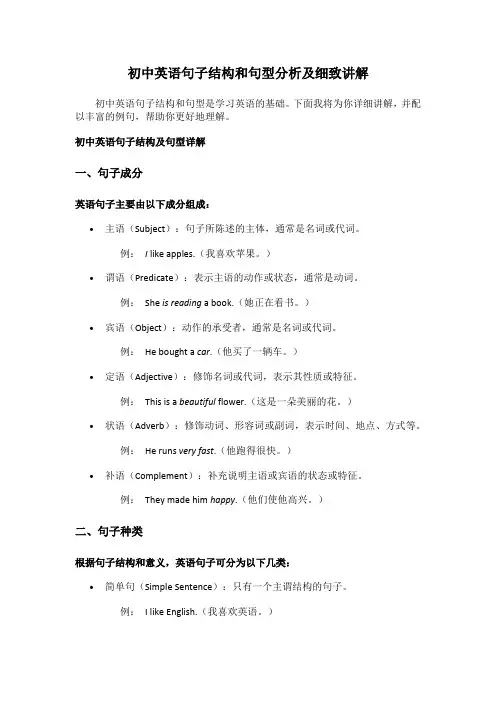
初中英语句子结构和句型分析及细致讲解初中英语句子结构和句型是学习英语的基础。
下面我将为你详细讲解,并配以丰富的例句,帮助你更好地理解。
初中英语句子结构及句型详解一、句子成分英语句子主要由以下成分组成:•主语(Subject):句子所陈述的主体,通常是名词或代词。
例:I like apples.(我喜欢苹果。
)•谓语(Predicate):表示主语的动作或状态,通常是动词。
例:She is reading a book.(她正在看书。
)•宾语(Object):动作的承受者,通常是名词或代词。
例:He bought a car.(他买了一辆车。
)•定语(Adjective):修饰名词或代词,表示其性质或特征。
例:This is a beautiful flower.(这是一朵美丽的花。
)•状语(Adverb):修饰动词、形容词或副词,表示时间、地点、方式等。
例:He runs very fast.(他跑得很快。
)•补语(Complement):补充说明主语或宾语的状态或特征。
例:They made him happy.(他们使他高兴。
)二、句子种类根据句子结构和意义,英语句子可分为以下几类:•简单句(Simple Sentence):只有一个主谓结构的句子。
例:I like English.(我喜欢英语。
)•并列句(Compound Sentence):由两个或两个以上的简单句用并列连词(and, but, or等)连接而成。
例:I like apples, and she likes bananas.(我喜欢苹果,她喜欢香蕉。
)•复合句(Complex Sentence):由一个主句和一个或多个从句组成。
例:When I go home, I will do my homework.(当我回家时,我将做作业。
)三、句子类型•陈述句(Declarative Sentence):用来陈述事实或观点。
例:He is a student.(他是一个学生。
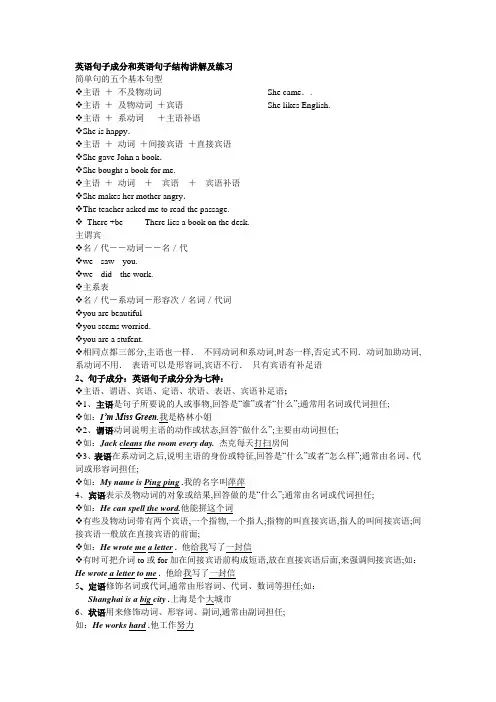
英语句子成分和英语句子结构讲解及练习简单句的五个基本句型❖主语+不及物动词She came..❖主语+及物动词+宾语She likes English.❖主语+系动词+主语补语❖She is happy.❖主语+动词+间接宾语+直接宾语❖She gave John a book.❖She bought a book for me.❖主语+动词+宾语+宾语补语❖She makes her mother angry.❖The teacher asked me to read the passage.❖There +be There lies a book on the desk.主谓宾❖名/代--动词--名/代❖we-- saw --you.❖we-- did --the work.❖主系表❖名/代-系动词-形容次/名词/代词❖you are beautiful❖you seems worried.❖you are a stufent.❖相同点都三部分,主语也一样.不同动词和系动词,时态一样,否定式不同.动词加助动词,系动词不用.表语可以是形容词,宾语不行.只有宾语有补足语2、句子成分:英语句子成分分为七种:❖主语、谓语、宾语、定语、状语、表语、宾语补足语;❖1、主语是句子所要说的人或事物,回答是“谁”或者“什么”;通常用名词或代词担任;❖如:I’m Miss Green.我是格林小姐❖2、谓语动词说明主语的动作或状态,回答“做什么”;主要由动词担任;❖如:Jack cleans the room every day. 杰克每天打扫房间❖3、表语在系动词之后,说明主语的身份或特征,回答是“什么”或者“怎么样”;通常由名词、代词或形容词担任;❖如:My name is Ping ping .我的名字叫萍萍4、宾语表示及物动词的对象或结果,回答做的是“什么”;通常由名词或代词担任;❖如:He can spell the word.他能拼这个词❖有些及物动词带有两个宾语,一个指物,一个指人;指物的叫直接宾语,指人的叫间接宾语;间接宾语一般放在直接宾语的前面;❖如:He wrote me a letter . 他给我写了一封信❖有时可把介词to或for加在间接宾语前构成短语,放在直接宾语后面,来强调间接宾语;如:He wrote a letter to me .他给我写了一封信5、定语修饰名词或代词,通常由形容词、代词、数词等担任;如:Shanghai is a big city .上海是个大城市6、状语用来修饰动词、形容词、副词,通常由副词担任;如:He works hard .他工作努力7、宾语补足语用来说明宾语怎么样或干什么,通常由形容词或动词充当;❖如:They usually keep their classroom clean.他们通常让教室保持清洁/❖He often helps me do my lessons.他常常帮我做功课/❖The teacher wanted me to learn French all by myself.老师要我自学法语8☆同位语通常紧跟在名词、代词后面,进一步说明它的情况;❖如:Where is your classmate Tom 你的同学汤姆在哪里1. 主语subject:句子说明的人或事物;The sun rises in the east 名词He likes dancing. 代词Twenty years is a short time in history. 数词Seeing is believing. 动名词To see is to believe.不定式What he needs is a book.主语从句It is very clear that the elephant is round and tall like a tree.It形式主语,主语从句是真正主语一指出下列句中主语的中心词①The teacher with two of his students is walking into the classroom.②There is an old man coming here.③The useful dictionary was given by my mother last year.④To do today's homework without the teacher's help is very difficult.谓语predicate:是对主语加以陈述,表示主语的行为或状态,常用动词或者动词词组担任,放在主语的后面;We study English. He is asleep.二. 选出句中谓语的中心词①I don't like the picture on the wall.A. don'tB. likeC. pictureD. wall②The days get longer and longer when summer comes. A. get B. longer C. days D. summer③Do you usually go to school by busA. DoB. usuallyC. goD. bus④There will be a meeting at the library this afternoon.A. will beB. meetingC. the libraryD. afternoon3. 表语predicative:系动词之后的成分,表示主语的性质、状态和特征;He is a teacher. 名词You don’t look it. 代词Five and five is ten. 数词He is asleep. 形容词His father is in. 副词The picture is on the wall. 介词短语My watch is gone / missing / lost. 形容词化的分词The question is whether they will come. 表语从句常见连系动词❖“存在”类:表示存在或具有某种特征或状态.这类连系动词强调“存在”;常见的有:be 是,look看起来,feel摸上去,seem似乎是,appear似乎、显得,prove证明是,smell闻起来,taste尝起来,sound听起来等;❖例如: The story sounds true.❖Those oranges taste good star.2. “持续”类:表示某种情况或状态的持续;这类连系动词强调“持续”;常见的有:remain依然,keep保持,stay保持,continue继续、仍旧,stand处于某状况或情形等;例如: Why don't you put the meat in the fridgeIt will stay fresh for several days.It's already ten in the morning.The store remains closed.What's the matter3. “变化”类:表示由一种情况或状态变化成另一种情况或状态;这类连系动词强调“变化”后的情况或状态.常见的有:become变成, turn变成, grow变得, get变得等;❖例如: Put the fish in the fridge, or it will go bad in hot weather.三挑出下列句中的表语①The old man was feeling very tired.②Why is he worried about Jim③The leaves have turned yellow.④Soon They all became interested in the subject.⑤She was the first to learn about it.①tired ②worried ③yellow ④interested ⑤first4. 宾语:1动宾表示行为的对象,常由名词或者代词担任;放在及物动词或者介词之后;如:I like China. 名词He hates you. 代词How many do you need We need two. 数词I enjoy working with you. 动名词I hope to see you again. 不定式Did you write down what he said 宾语从句2介词后的名词、代词和动名词-----介宾Are you afraid of the snakeUnder the snow, there are many rocks.3双宾语-----间宾指人和直宾指物He gave me a book yesterday.Give the poor man some money四挑出下列句中的宾语❖①My brother hasn't done his homework.❖②People all over the world speak English.❖③You must pay good attention to your pronunciation.❖④How many new words did you learn last class❖❖⑤Some of the students in the school want to go swimming.❖his homework ②English ③your pronunciation ④new words ⑤to go swimming 5. 宾补:对宾语的补充,全称为宾语补足语;❖We elected him monitor. 名词❖We all think it a pity that she didn’t come here. 名词❖We will make them happy. 形容词❖We found nobody in. 副词❖Please make yourself at home. 介词短语Don’t let him do that. 省to不定式❖His father advised him to teach the lazy boy a lesson. 带to不定式❖Don’t keep the lights burning. 现在分词❖I’ll h ave my bike repaired. 过去分词扩展:❖主补:对主语的补充;❖He was elected monitor.❖She was found singing in the next room.❖He was advised to teach the lazy boy a lesson.五挑出下列句中的宾语补足语❖①She likes the children to read newspapers and books in the reading-room.❖②He asked her to take the boy out of school.❖③She found it difficult to do the work.❖④They call me Lily sometimes.❖⑤I saw Mr. Wang get on the bus.❖⑥Did you see Li Ming playing football on the playground just now❖❖①to read newspapers and books in the reading-room ②to take the boy out of school❖③Lily ④get on the bus ⑤playing football on the playground❖划出句中的直接宾语和间接宾语❖①Please tell us a story.❖②My father bought a new bike for me last week.❖③Mr. Li is going to teach us history next term.❖④Here is a pen. Give it to Tom.❖⑤Did he leave any message for me❖6. 定语:修饰或限制名词或代词的词、词组或句子;❖Yanling is a chemistry teacher.名词❖He is our friend. 代词❖We belong to the third world.数词❖He was advised to teach the lazy boy a lesson.形容词❖The man over there is my old friend.副词❖The woman with a baby in her arms is my sister. 介词The boys playing football are in Class 2. 现在分词The trees planted last year are growing well now. 过去分词I have an idea to do it well.不定式You should do everything that I do. 定语从句六挑出下列句中的定语❖①They use Mr., Mrs. with the family name.❖②What is your given name❖❖③On the third lap are Class 1 and Class 3.❖④I am afraid some people forgot to sweep the floor.❖⑤The man downstairs was trying to sleep.①family ②given ③third ④some ⑤downstairs7. 状语:用来修饰v., adj., adv., or 句子;表示时间、地点、原因、目的、结果、程度、条件、方式和让步;以下例句按上述顺序排列❖I will go there tomorrow.❖The meeting will be held in the meeting room.❖The meat went bad because of the hot weather.❖He studies hard to learn English well.❖He didn’t st udy hard so that he failed in the exam.❖I like some of you very much.❖If you study hard, you will pass the exam.❖He goes to school by bike.❖Though he is young, he can do it well.七挑出下列句中的状语❖①There was a big smile on her face.❖②Every night he heard the noise upstairs.❖③He began to learn English when he was eleven.❖④The man on the motorbike was travelling too fast.❖⑤With the medicine box under her arm, Miss Li hurried off.❖①on the face ②Every night ③when he was eleven ④fast ⑤With the medicinebox under her arm八、同位语❖当一个概念词在前,后面的词、词组或者句子是在解释前者时,而且两者的语法功能相同,后者就是前者的同位语;❖Mr. Black, our English teacher, is a good tennis player.❖我们的英语老师——布莱克先生是个优秀的网球手;❖Football, the only interest in life, has brought him many friends.❖足球----他唯一的爱好,让他结交了许多朋友;Yesterday I met Tom, a friend of my brother's.❖昨天我遇到了我弟弟的朋友汤姆;That’s her habit, reading in bed.❖躺在床上看书是她的习惯;❖Your suggestion, to strike while the iron is hot, seemed a good idea.❖你建议趁热打铁,这个建议很好;He gave orders that the work should be started immediately.❖他发出指示要立即开始工作;You still haven’t answered my question why you didn’t come to school yesterday.❖你还没有回答我昨天为什么没有上学;同位语从句常跟在某些名词后,对其作进一步的解释;这些名词包括:fact, doubt, idea, news,hope, indication, decision, possibility, assumption, suggestion, question.这类从句常常有that 引导,有时也可以用what, why, whether, when 等引导;九插入语❖插入语是说话者对所表达的意思的补充、强调、解释或者说话的态度,其位置灵活常常用逗号或者破折号分开,并且在语法上不影响其他成份;❖1. 插入语常以副词副词短语、形容词形容词短语、介词短语、短语等形式出现;❖ 1 常见的副词及短语:indeed, surely, however, obviously, frankly, naturally, luckily / happily for sb. certainly 等;九■There be 句型拓展:There be +句词词组”中,there为虚词,be后面的名词词组为句子的真正主语;该句式在使用时须注意如下几点:★There be句式表示“有”时,它表示一种存在关系,通常带有一个地点状语,意为“什么地方时候有……”;句式中的主语只能为表泛指的名词词组,此外,其主语还可以带前置或后置定语;例如:1. There is a blackboard in the classroom.2. There are five minutes to go.3. There are two old women waiting for you at the gate.★在正式文体中,该句式中be动词的单复数形式取决于以下两种情况:❖1该句式中只有一个主语,主语为单数时,be动词用单数;主语若为复数,be动词也用复数; ❖2该句式中有几个并列主语,则按就近原则处理,即与靠近be动词的第一个主语保持一致;例如:❖1. There is room for improvement.❖2. There are three apples on the table.❖3. There were only two pens, a dictionary and a textbook on the desk.★“There be +主语+不定式”中,不定式可以有主动和被动两种形式,不过在口语中主动形式更为常见;例如:1. There is a letter to type today.2. There is no time to lose.3. There are many things to be done now.★There be句式中,be动词有各种变化形式;1be动词有时态变化,可以为一般现在时、一般过去时、现在完成时、过去完成时、将来时等;例如:1. There are a lot of people in the meeting-room.2. There was little left.3. There have been many such traffic accidents in the past few years.4. When he got there, he found there had been no one waiting for him in the room.5. Without air, there would be no living things.6. There is going to be a storm tomorrow morning.2There be句式中,be之前可以有情态动词;例如:❖1. There may be some people who don’t like the film.❖2. There used to be a temple in the village.句子种类一按使用目的可分为陈述句、疑问句、祈使句和感叹句;❖1 陈述句Declarative Sentences:说明一个事实或陈述一种看法;❖Light travels faster than sound.光比声速度快;❖The film is rather boring.这部电影很乏味;❖I haven’t got a camera. 我没有相机.❖They have never met before. 他们以前从没见过面.疑问句Interrogative Sentences:提出问题;有以下四种:a.一般疑问句General Questions:❖Can you finish the work in time❖你能按时完成工作吗❖b.特殊疑问句W Questions; H Questions❖Where do you live❖你住那儿❖How do you know that 你怎么知道那件事c.选择疑问句Alternative Questions:❖Do you want tea or coffee❖❖❖你是要茶还是要咖啡❖d.反意疑问句Tag-Questions:❖He knows her, doesn’t he❖❖他不认识她,对不对= Does he know her❖yes, he does.❖No , he doesn’t.3 祈使句Imperative Sentences:提出请求,建议或发出命令,例如:❖Sit down, please.请坐;❖Don't be nervous 别紧张4 感叹句Exclamatory Sentences:表示说话人惊奇、喜悦、愤怒等情绪,例如:❖What good news it is 多好的消息啊❖How good the news is❖What beautiful flowers they are 多美丽的花啊❖How beautiful the flowers are❖How lovely the child is 多可爱的小孩啊❖What a lovely child he is❖what a cute child he is二句子按其结构可以分为以下三类:❖1 简单句Simple Sentences:只包含一个主谓结构句子叫简单句,例如:❖She is fond of collecting stamps.❖她喜欢集邮;❖We all study hard.❖我们都努力学习.I love sports very much.❖我非常喜欢运动.❖Mum made a beautiful skirt for me.❖妈妈为我做了一条漂亮的裙子.❖We elected him our class president.❖我们选了他做班长.❖There are more than 3000 students in our school.❖我们学校的学生超过3000名.2 并列句Compound Sentences:由两个或两个以上的简单句并列连接起来的句子叫并列句. ❖The food was good, but he had little appetite.❖食物很精美,但他却没什么胃口;❖Let’s hurry, or we will be late.❖咱们赶紧点,要不就迟到啦.❖He studied hard , and he passed the exam.❖他努力学习并通过了考试.❖He felt no fear, for he was very brave.❖他很勇敢,毫不畏惧.❖He was sick, so they were quiet.❖他病了,所以他们很安静.3 复合句Complex Sentences:包含一个主句从句和一个或几个从句的句子叫复合句,从句由从属连词引导,例如:❖The film had begun when we got to the cinema.❖我们到达电影院的时候,电影已经开演了;❖Do you know the man who is in the car❖你认识坐在汽车里的人吗❖❖What he said is not true.❖他说的不是实话.I know it’s difficult to master a foreign language.❖我知道学好一门外语不容易.❖The question is whether he will join us next time.❖问题是下次他是否跟我们一起干.❖The idea that Iraq could be taken within a week or two was an underestimation.❖伊拉克可以在一两周内就可以拿下的这一想法是估计不足的想法.❖To get into university = If you want to get into university you have to pass a number of exams.❖进入大学,你必须通过一系列的考试.元音和辅音的定义:发音时声带振动,呼出的气流通过口腔时不受阻碍,这样形成的语音称为元音;不论声带振动与否,发音时呼出的气流通过口腔或鼻腔时受到一定的阻碍,这样形成的语音称为辅音;发音时声带不振动的辅音称为清辅音;发音声带振动的辅音称为浊辅音;巧记48个国际音标单元音共十二,四二六前中后双元音也好背,合口集中八个辅音共计二十八八对一清又七浊,四个连对也包括;有气无声清辅音,有声无气浊辅音,发音特点应掌握1. 音标必须写在括号里,常用的音标括号有斜头和平头两种,其上端不顶第一线,大致与大写字母相齐,下端在第三格的中2. 音标没有书写体,也没有大小写,因此书写时必须和印刷体一样,直上直下,没有斜度,其书写规格如下所列;3. 下面几个音标是最容易写错的,一定要注意:ai和au不要写成Ai和Au,A:不要写成a:;在打字的时候,不要用a来代替A,把A:打成a:,也不要用g来代替G,把GE:l打成gE:l;4. 音标没有书写体,也没有大小写,因此书写时必须和印刷体一样,直上直下,没有斜度,其书写规格如下页所列元音音标学习元音概述:元音是有噪音的语音;形成元音时,声带振动,气流经由咽腔和口腔逸出时,不受到任何阻碍,没有可以听得到的摩擦声;英语里共有20个元音单元音12个,双元音8个;•元音之间的差异,是由发音时各发音器官所采取的不同位置形成的;所谓“不同位置”,指的是舌头的高低与前后,牙床的开合程度,以及唇形的大小和圆扁;但其中决定的因素是舌头的位置:舌头是在口腔的前部、中部或者后部,决定所发的音是前元音、中元音还是后元音;舌身隆起的高度以及舌的哪一部分隆起最高,决定发出的元音是开口元音、半开元音、合口元音、还是半合元音;牙床开合的程度是由舌位的高低所决定的,而双唇的圆扁和大小对形成不同的元音也有相当的影响;因此,描述一个元音的发音部位,主要是描述它的舌位和唇形; Lesson 1元音i: i ә: ә学习i: 发这个音的字母和字母组合e ea eee: me be she he we eveningee:sweet bee sweep sheep see sleep three greenea:meat leaf sea pea teach eat clean根据发音规则,圈出下列单词中元音字母组合发音相同的两个词;rain bean catfeet teacher dstar tree jeepsea fish thei 发这个音的字母和字母组合i e y ey ay•i: pig fish in fifteen six ship thin•e: begin behind jacket basketball•y: happy heavy busy lorry carry sunny•lovely study thirsty twenty thirty windy rainy•ey: monkey money•ay:Sunday Saturday Friday根据发音规则,圈出每组中元音字母发音不相同的单词; •sit kick lip•gift jam ship•picture big sister•lick pig jellyә: 发这个音的字母和字母组合er ir ur ear orer: her serve termir:bird girl skirt first dirty skirt shirtur:nurse Thursday turtle purple curtainear:early learnor: word work world根据发音规则,圈出每组中元音字母组合发音相同的单词;beer thirsty wheat2. bank king her nursebird rabbit kneerun shirt termә发这个音的字母和字母组合ure er ar or a eure: pictureer:teacher brother dinner father sisterar: sugaror:doctora:panda about above camera sofa China根据发音规则,找出发ә的2个单词写在后面的横线上;sofa road smilefather sister food3. hair deer tiger Chinasoon ear leaderLesson 2音标ɔ: ɔu: u学习ɔ发这个音的字母和字母组合o ao: fox coffee dog shop dogdoctor longa: watch根据发音规则,找出发ɔ:的2个单词写在后面的横线上;teacher box clotheszoo clock dogboss lot violinbeach fox girlu: 发这个音的字母和字母组合o oo uio: do who whoseoo: food moon tooui: fruit juiceu: ruler rude根据发音规则,找出不发u:的单词;1. juice moon zoo panda2. tooth broom eye spoon3. head boot noodles pool4. noon cool boot watchu发这个音的字母和字母组合o oo uo:woman wolf•oo:look good book foot woodu:bull bullet•根据发音规则,选出与其它单词元音发音不相同的单词;book look pulltape sugar footkind wolf bullwood cook name四. 写出单词或音标;•bru:m dɔ: sit bә:d•fut wi: dɔg ′sistә•look do water good •too foot clock first •work sister doctor sea •五. 将下列单词与正确的音标用线连起来;•hot blu:•football huk•blue ki:shook futbɔ:lkiss hɔtLesson 3音标a: Λæ e 练习a: 发这个音的字母和字母组合a ar au ear•a: grass glass class plant dance fastfather lastar: car star arm March garden dark scarfau: laugh auntear: heart•根据发音规则,圈出发a:的2个单词;lip doctor card• 2. cloud cart garden gatescarf dark tiger•4. job lorry March parkΛ发这个音的字母和字母组合o u oo ouo: son come colour love moneyu: sun nut jump gum bus brushsupper usou: touch cousin country•根据发音规则,找出每组中发Λ的单词;cup bed air2. voice boy duck antcorn bear gun 4. cute boy money heræ 发这个音的字母和字母组合aa: dad cap cat bad apple bag flaghand rabbit ant black fat hasstand rat map根据发音规则,找出每组中发æ的单词;bed face sportcup fat pearbat finger treeyoung knife applee 发这个音的字母和字母组合e eae: egg bell desk leg pet ten penea: bread head breakfast•根据发音规则,找出每组中不发e的单词;well leg penmap pet elephantten tall deskhead bed toy音标a: Λæ e 练习•一.抄写音标,一个抄写5遍;•a::Λ:æ:e:____ •二.选出下列没有相同发音的词;• 1. car arm food garden• 2. true jump bus cut• 3. bag short map flag• 4. egg pen head small• 5. got clock bell dog• 6. rabbit book wood foot•7. rat bat apple ten•8. gun star duck moneg•三. 写出单词或音标;•pa:st ru:m swet sit•fæt gɔt cΛp shә:t•bag car bus bread star head•四. 选出下列每题中元音有几种读音,有一种读音的在里画☆,有两种读音的画△,有三种的画◇• 1. hat fast cook last• 2. jeep door sun gum• 3. dad cap hand map• 4. star car cut from• 5. skirt sheep bird her•五. 改变下列单词的一个字母,使它变成另一个单词•like_________________交通工具•hat ________________动物•lake ________________食品•nice _______________数字•hot _________________用品•well _______________用品Lesson 4元音音标ei ai ɔi au练习ai 发这个音的字母和字母组合i y ie uy•i: kite bike nice tiger write knife•y: by cry fly my sky try why•ie:tie pie•uy:buy•根据发音规则,找出每组中发ai的2个单词.•good jam right•mine ice-cream mouse•sit tie eye•small tennis kiteɔi 发这个音的字母和字母组合oi oy •oi: oil boil coin•oy: boy toy根据发音规则,找出每组中发ɔi的2个单词. hear soy cold2. rabbit bed boy noisevoise boil word4. tea enjoy toy milkau 发这个音的字母和字母组合ou ow ou: house mouse mouth trousersow: flower cow how now down •根据发音规则,选出不发au的单词; 1.mouse cloud arm clowntrousers cow mouth3. town dance flower houseblouse now baby四. 把下列单词下正确的音标连接起来•bow bau•gate pai•tray geit•pie trei •poison pɔizn五. 看图、填空、标号•h___t→s__n→e__ __s__ r→•r__l__ __→c__k___→m__ __th Lesson 5元音音标әu iәeәuә的练习әu 发这个音的字母和字母组合o oa owo: nose rose poen overoa: boat coat soap goatow:show window snow bowl根据发音规则,圈出每组中发әu的2个单词;1.coat goat tree riverwindow knife road3. your white row coathen nose lampiә发这个音的字母和字母组合ear eer ear: ear hear teareer: deer beer根据发音规则,圈出每组中发iә的1个单词;beer fair tailpair near comenear tower air4. ring king here threeeә发这个音的字母和字母组合air earair: hair chair pairear:pear bear wear根据发音规则,圈出每组中发eә的1个单词;idea pineapple tailpair climb comehouse tower air4. ring king hare threeuә发这个音的字母和字母组合oor our ureoor: poorour: tourure: sure pure根据发音规则,圈出每组中发uә的1个单词;tourist pineapple tailpair climb furycure tower air4. voice king pure engineer辅音爆破音:ptk bdg摩擦音:f v s z θð破擦音:tr dr ts dz t∫t3鼻辅音:m n η舌侧音:1出现在元音之前叫作清晰舌边音2出现在辅音及单词末尾时叫作模糊舌边音半元音:擦音中气流较弱,摩擦较小,介于元音跟辅音之间的音w j •3 ∫•h rLesson 6辅音音标p b t d练习p 发这个音的字母和字母组合p ppp: piano panda parrot pet shipsheep pig stoppp: apple happy根据发音规则,圈出没有发p的单词;phone sleep pearpen big pineappleparrot sheep pigpony pet truckb发这个音的字母和字母组合b bbb: book ball bird big boy bagbananabb:rubber rabbit cabbage根据发音规则,圈出发b的2个单词;gift beach love2. pet god tub bedboy bus makeread dress babyt发这个音的字母和字母组合t ttt: table tea taxi cat rat fat ticketTt: butter matter根据发音规则,圈出没有发t的1个单词;fat bag toyticket tea duckpacket cat raind发这个音的字母和字母组合d edd: duck seed door desk day redhead bed read colded: smiled opened played根据发音规则,圈出没有发d的1个单词;clothes handcold fiveduck grape音标p b t d练习一.抄写音标,一个抄写5遍;•p:b:t:d:_______ 二. 选出下列没有相同发音的词• 1. pear ship coat pig• 2. taxi bean cab cabbage• 3. hat sea ticket wallet• 4. seed dance hand full• 5. pick pen sit pineapple• 6. cold find door chair•7. cloth purple pool push•8. eat fan quiet set三.写出单词或音标;•pændәkΛt di:p klaud •apple pear rabbit read 四. 改变下列单词的一个字母,使它变成另一个单词;•short→_____________衣物sea→_________________感官动词•pet →______________蔬菜ten→___________________ 动物Lesson 7辅音音标k g s z学习g发这个音的字母和字母组合g ggg: glass golf get girl bag goatflaggg: egg根据发音规则,圈出发g的单词;gas drive gum give violin bagjeans orange log bridge guesstank grade long languages发这个音的字母和字母组合s c ss ces: star sun snake sea seec: pencil city cedar ceiling celebratess: grass glass class bossce: face race rice nice根据发音规则,圈出每组中2个发s的单词;1. whose juice lick student2. those case scarf shoes3. space nose science meat4. tears piece bus noseLesson 8辅音音标∫3 t∫d3练习3发这个音的字母和字母组合ss: television, usually, Asiameasure a garage,an unusual collision; a great decision;my pleasure根据发音规则,圈出下列单词中发3的2个单词;1. shell ship garage desk2. truck shirt pleasure ship3. brush casual sheep sleep4. hero shape leisure shelft∫发这个音的字母和字母组合ch tchch: teacher peach cherry chairtch: watch match根据发音规则,找出下列单词中发t∫的单词,并抄下来;chair dumpling beach cheesenight she monkeyChina church these flower eggdream shark chick catchLesson 9音标f v θð的练习v发这个音的字母和字母组合v vev: video vase vestve: five love violin根据发音规则,在不发v的单词上打×violin move vote windowvan volcano white womanvictory wet wave vaseð发这个音的字母和字母组合thth: father mother brother clothesweather根据发音规则,圈出每组中发ð的1个单词;1.than sister brother three2. weather thank night good3. tie look teeth they4. thin father throat watchLesson 10辅音音标tsdz tr dr的练习dz 发这个音的字母和字母组合ds desds: seeds woods friends birds bedsdes: rides根据发音规则,找出发dz的5个单词写在后面的横线上;coats hands cats kitesbeds words pets kidsseats horse sands gatestr 发这个音的字母和字母组合trtr: tree truck trousers strawberry trick根据发音规则,找出没有发tr的3个单词写在后面的横线上; seats truck train trash tractordrink street drug trousersdr 发这个音的字母和字母组合drdr: draw drink driver dragon dry根据发音规则,找出每组中发dr的2个单词写在后面的横线上;1. dream duck dress rain2. rat drain drug door3. tree treasure drawer drink4. truck dragon dish drumLesson 11辅音音标hrlm的练习r 发这个音的字母和字母组合r rr wrr: rice room ride road roserr: mirror carrot parrotwr: write wrong wrap根据发音规则,选出发r的单词,打√;1. bread driver wrong rain worker2. river father robot rope sister3. write fruit rabbit crown druml 发这个音的字母和字母组合l ll•l: look light lock lucky lion tail•ll: ball pull dollar tell根据发音规则,选出每组中不发l的单词;• 1. lamp nail flag woman• 2. yellow fruit lion lychee• 3. grape bull laugh lake• 4. dumpling moon wheel whaleLesson 12音标n ηw j的练习n发这个音的字母和字母组合n kn gnn: nose net nut banana noodles train rain plane down kn: knee knife knockgn: sign根据发音规则,找出发n的单词并抄下来;1. mirror wheel yes knock2. mall hen laugh nut3. earrings plane wing breadη发这个音的字母和字母组合n ngn: ink bank tank fingerng: sing hang song king reading running根据发音规则,从下列每组中找出2个发η的单词;1.net ring finger meat2. tennis mouth song swing3. dumpling wing run nail4. hang swim ink notew发这个音的字母和字母组合w: winter window watch water well wouldwh: white where which when why wheel whale根据发音规则,选出每组中不发w音的1个单词;1. wood write wheel which2. wheat snow wet woman3. white window now why4. whale water watch rowj发这个音的字母和字母组合yy: yo-yo yogurt yard yes you your根据发音规则,找出发j的单词写在下面横线上;cry you your sky yellow lorrymoney jelly toy boy yogurt soy。
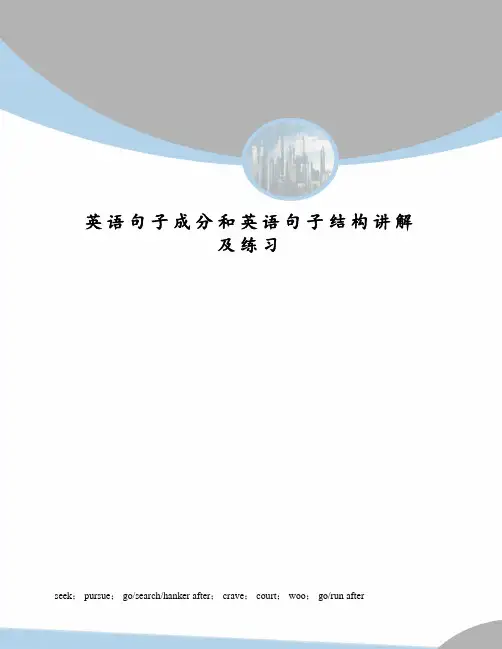
英语句子成分和英语句子结构讲解及练习seek; pursue; go/search/hanker after; crave; court; woo; go/run after英语句子成分和英语句子结构讲解及练习简单句的五个基本句型主语+不及物动词Shecame..主语+及物动词+宾语ShelikesEnglish.主语+系动词+主语补语Sheishappy.主语+动词+间接宾语+直接宾语ShegaveJohnabook.Sheboughtabookforme.主语+动词+宾语+宾语补语Shemakeshermotherangry.Theteacheraskedmetoreadthepassage.There+beThereliesabookonthedesk.主谓宾名/代--动词--名/代we--saw--you.we--did--thework.主系表名/代-系动词-形容次/名词/代词youarebeautifulyouseemsworried.youareastufent.相同点都三部分,主语也一样.不同动词和系动词,时态一样,否定式不同.动词加助动词,系动词不用.表语可以是形容词,宾语不行.只有宾语有补足语2、句子成分:英语句子成分分为七种:主语、谓语、宾语、定语、状语、表语、宾语补足语.1、主语是句子所要说的人或事物,回答是“谁”或者“什么”.通常用名词或代词担任.如:I’mMissGreen.我是格林小姐2、谓语动词说明主语的动作或状态,回答“做什么”.主要由动词担任.如:Jackcleanstheroomeveryday.杰克每天打扫房间3、表语在系动词之后,说明主语的身份或特征,回答是“什么”或者“怎么样”.通常由名词、代词或形容词担任.如:MynameisPingping.我的名字叫萍萍4、宾语表示及物动词的对象或结果,回答做的是“什么”.通常由名词或代词担任.如:Hecanspelltheword.他能拼这个词有些及物动词带有两个宾语,一个指物,一个指人.指物的叫直接宾语,指人的叫间接宾语.间接宾语一般放在直接宾语的前面.如:Hewrotemealetter.他给我写了一封信有时可把介词to或for加在间接宾语前构成短语,放在直接宾语后面,来强调间接宾语.如:Hewrotealettertome.他给我写了一封信5、定语修饰名词或代词,通常由形容词、代词、数词等担任.如:Shanghaiisabigcity.上海是个大城市6、状语用来修饰动词、形容词、副词,通常由副词担任.如:Heworkshard.他工作努力7、宾语补足语用来说明宾语怎么样或干什么,通常由形容词或动词充当.如:Theyusuallykeeptheirclassroomclean.他们通常让教室保持清洁/Heoftenhelpsmedomylessons.他常常帮我做功课/ TheteacherwantedmetolearnFrenchallbymyself.老师要我自学法语8☆同位语通常紧跟在名词、代词后面,进一步说明它的情况.如:WhereisyourclassmateTom你的同学汤姆在哪里1.主语subject:句子说明的人或事物.Thesunrisesintheeast名词Helikesdancing.代词Twentyyearsisashorttimeinhistory.数词Seeingisbelieving.动名词Toseeistobelieve.不定式Whatheneedsisabook.主语从句Itisveryclearthattheelephantisroundandtalllikeatree.It形式主语,主语从句是真正主语一指出下列句中主语的中心词①Theteacherwithtwoofhisstudentsiswalkingintotheclassroom.②Thereisanoldmancominghere.③Theusefuldictionarywasgivenbymymotherlastyear.④Todotoday'shomeworkwithouttheteacher'shelpisverydifficult.谓语predicate:是对主语加以陈述,表示主语的行为或状态,常用动词或者动词词组担任,放在主语的后面.WestudyEnglish.Heisasleep.二.选出句中谓语的中心词①Idon'tlikethepictureonthewall.A.don'tB.likeC.pictureD.wall②Thedaysgetlongerandlongerwhensummercomes.A.getB.longerC.daysD.summer③DoyouusuallygotoschoolbybusA.DouallyC.goD.bus④Therewillbeameetingatthelibrarythisafternoon.A.willbeB.meetingC.thelibraryD.afternoon3.表语predicative:系动词之后的成分,表示主语的性质、状态和特征.Heisateacher.名词Youdon’tlook it.代词Fiveandfiveisten.数词Heisasleep.形容词Hisfatherisin.副词Thepictureisonthewall.介词短语Mywatchisgone/missing/lost.形容词化的分词Thequestioniswhethertheywillcome.表语从句常见连系动词“存在”类:表示存在或具有某种特征或状态.这类连系动词强调“存在”.常见的有:be是,look看起来,feel摸上去,seem似乎是,appear似乎、显得,prove证明是,smell闻起来,taste尝起来,sound听起来等.例如:Thestorysoundstrue.Thoseorangestastegoodstar.2.“持续”类:表示某种情况或状态的持续.这类连系动词强调“持续”.常见的有:remain依然,keep保持,stay保持,continue继续、仍旧,stand处于某状况或情形等.例如:Whydon'tyouputthemeatinthefridgeItwillstayfreshforseveraldays.It'salreadyteninthemorning.Thestoreremainsclosed.What'sthematter3.“变化”类:表示由一种情况或状态变化成另一种情况或状态.这类连系动词强调“变化”后的情况或状态.常见的有:become变成,turn变成,grow变得,get变得等.例如:Putthefishinthefridge,oritwillgobadinhotweather.三挑出下列句中的表语①Theoldmanwasfeelingverytired.②WhyisheworriedaboutJim③Theleaveshaveturnedyellow.④SoonTheyallbecameinterestedinthesubject.⑤Shewasthefirsttolearnaboutit.①tired ②worried ③yellow ④interested ⑤first4.宾语:1动宾表示行为的对象,常由名词或者代词担任.放在及物动词或者介词之后.如:IlikeChina.名词Hehatesyou.代词Howmanydoyouneed Weneedtwo.数词Ienjoyworkingwithyou.动名词Ihopetoseeyouagain.不定式Didyouwritedownwhathesaid宾语从句2介词后的名词、代词和动名词-----介宾AreyouafraidofthesnakeUnderthesnow,therearemanyrocks.3双宾语-----间宾指人和直宾指物Hegavemeabookyesterday.Givethepoormansomemoney四挑出下列句中的宾语①Mybrotherhasn'tdonehishomework.②PeopleallovertheworldspeakEnglish.③Youmustpaygoodattentiontoyourpronunciation.④Howmanynewwordsdidyoulearnlastclass⑤Someofthestudentsintheschoolwanttogoswimming.hishomework ②English ③yourpronunciation ④newwords ⑤togoswimming5.宾补:对宾语的补充,全称为宾语补足语.Weelectedhimmonitor.名词Weallthinkitapity thatshedidn’tcomehere.名词Wewillmakethemhappy.形容词Wefoundnobodyin.副词Pleasemakeyourselfathome.介词短语Don’tlethim dothat.省to不定式Hisfatheradvisedhimtoteachthelazyboyalesson.带to不定式Don’tkeepthelights burning.现在分词I’llhavemybike repaired.过去分词扩展:主补:对主语的补充.Hewaselectedmonitor.Shewasfoundsinginginthenextroom.Hewasadvisedtoteachthelazyboyalesson.五挑出下列句中的宾语补足语①Shelikesthechildrentoreadnewspapersandbooksinthereading-room.②Heaskedhertotaketheboyoutofschool.③Shefounditdifficulttodothework.④TheycallmeLilysometimes.⑤IsawMr.Wanggetonthebus.⑥DidyouseeLiMingplayingfootballontheplaygroundjustnow①toreadnewspapersandbooksinthereading-room ②totaketheboyoutofschool ③Lily ④getonthebus ⑤playingfootballontheplayground划出句中的直接宾语和间接宾语①Pleasetellusastory.②Myfatherboughtanewbikeformelastweek.③Mr.Liisgoingtoteachushistorynextterm.④Hereisapen.GiveittoTom.⑤Didheleaveanymessageforme6.定语:修饰或限制名词或代词的词、词组或句子.Yanlingisachemistryteacher.名词Heisourfriend.代词Webelongtothethirdworld.数词Hewasadvisedtoteachthelazyboyalesson.形容词Themanoverthereismyoldfriend.副词Thewomanwithababyinherarmsismysister.介词TheboysplayingfootballareinClass2.现在分词Thetreesplantedlastyeararegrowingwellnow.过去分词Ihaveanideatodoitwell.不定式YoushoulddoeverythingthatIdo.定语从句六挑出下列句中的定语①TheyuseMr.,Mrs.withthefamilyname.②Whatisyourgivenname③OnthethirdlapareClass1andClass3.④Iamafraidsomepeopleforgottosweepthefloor.⑤Themandownstairswastryingtosleep.①family ②given ③third ④some ⑤downstairs7.状语:用来修饰v.,adj.,adv.,or句子.表示时间、地点、原因、目的、结果、程度、条件、方式和让步.以下例句按上述顺序排列Iwillgotheretomorrow.Themeetingwillbeheldinthemeetingroom.Themeatwentbadbecauseofthehotweather.HestudieshardtolearnEnglishwell.Hedidn’tstudyhard sothathefailedintheexam.Ilikesomeofyouverymuch.Ifyoustudyhard,youwillpasstheexam.Hegoestoschoolbybike.Thoughheisyoung,hecandoitwell.七挑出下列句中的状语①Therewasabigsmileonherface.②Everynightheheardthenoiseupstairs.③HebegantolearnEnglishwhenhewaseleven.④Themanonthemotorbikewastravellingtoofast.⑤Withthemedicineboxunderherarm,MissLihurriedoff.①ontheface ②Everynight ③whenhewaseleven ④fast ⑤Withthemedicineboxunderherarm 八、同位语当一个概念词在前,后面的词、词组或者句子是在解释前者时,而且两者的语法功能相同,后者就是前者的同位语.Mr.Black,ourEnglishteacher,isagoodtennisplayer.我们的英语老师——布莱克先生是个优秀的网球手.Football,theonlyinterestinlife,hasbroughthimmanyfriends.足球----他唯一的爱好,让他结交了许多朋友.YesterdayImetTom,afriendofmybrother's.昨天我遇到了我弟弟的朋友汤姆.That’sherhabit,readinginbed.躺在床上看书是她的习惯.Yoursuggestion,tostrikewhiletheironishot,seemedagoodidea.你建议趁热打铁,这个建议很好. Hegaveordersthattheworkshouldbestartedimmediately.他发出指示要立即开始工作.Youstillhaven’tansweredmyquestionwhyyoudidn’tcometoschoolyesterday.你还没有回答我昨天为什么没有上学.同位语从句常跟在某些名词后,对其作进一步的解释.这些名词包括:fact,doubt,idea,news,hope,indication,decision,possibility,assumption,suggestion,ques tion.这类从句常常有that引导,有时也可以用what,why,whether,when等引导.九插入语插入语是说话者对所表达的意思的补充、强调、解释或者说话的态度,其位置灵活常常用逗号或者破折号分开,并且在语法上不影响其他成份.1.插入语常以副词副词短语、形容词形容词短语、介词短语、短语等形式出现.1常见的副词及短语:indeed,surely,however,obviously,frankly,naturally,luckily/happilyforsb.certainly等.九■Therebe句型拓展:Therebe+句词词组”中,there为虚词,be后面的名词词组为句子的真正主语.该句式在使用时须注意如下几点:★Therebe句式表示“有”时,它表示一种存在关系,通常带有一个地点状语,意为“什么地方时候有……”.句式中的主语只能为表泛指的名词词组,此外,其主语还可以带前置或后置定语.例如:1.Thereisablackboardintheclassroom.2.Therearefiveminutestogo.3.Therearetwooldwomenwaitingforyouatthegate.★在正式文体中,该句式中be动词的单复数形式取决于以下两种情况:1该句式中只有一个主语,主语为单数时,be动词用单数;主语若为复数,be动词也用复数.2该句式中有几个并列主语,则按就近原则处理,即与靠近be动词的第一个主语保持一致.例如:1.Thereisroomforimprovement.2.Therearethreeapplesonthetable.3.Therewereonlytwopens,adictionaryandatextbookonthedesk.★“Therebe+主语+不定式”中,不定式可以有主动和被动两种形式,不过在口语中主动形式更为常见.例如:1.Thereisalettertotypetoday.2.Thereisnotimetolose.3.Therearemanythingstobedonenow.★Therebe句式中,be动词有各种变化形式.1be动词有时态变化,可以为一般现在时、一般过去时、现在完成时、过去完成时、将来时等.例如:1.Therearealotofpeopleinthemeeting-room.2.Therewaslittleleft.3.Therehavebeenmanysuchtrafficaccidentsinthepastfewyears.4.Whenhegotthere,hefoundtherehadbeennoonewaitingforhimintheroom.5.Withoutair,therewouldbenolivingthings.6.Thereisgoingtobeastormtomorrowmorning.2Therebe句式中,be之前可以有情态动词.例如:1.Theremaybesomepeoplewhodon’tlikethefilm.2.Thereusedtobeatempleinthevillage.句子种类一按使用目的可分为陈述句、疑问句、祈使句和感叹句.1陈述句DeclarativeSentences:说明一个事实或陈述一种看法. Lighttravelsfasterthansound.光比声速度快.Thefilmisratherboring.这部电影很乏味.Ihaven’tgotacamera.我没有相机.Theyhavenevermetbefore.他们以前从没见过面.疑问句InterrogativeSentences:提出问题.有以下四种:a.一般疑问句GeneralQuestions:Canyoufinishtheworkintime你能按时完成工作吗b.特殊疑问句WQuestions;HQuestionsWheredoyoulive 你住那儿Howdoyouknowthat 你怎么知道那件事c.选择疑问句AlternativeQuestions:Doyouwantteaorcoffee你是要茶还是要咖啡d.反意疑问句Tag-Questions:Heknowsher,doesn’the他不认识她,对不对=Doesheknowheryes,hedoes.No,hedoesn’t.3祈使句ImperativeSentences:提出请求,建议或发出命令,例如:Sitdown,please.请坐.Don'tbenervous别紧张4感叹句ExclamatorySentences:表示说话人惊奇、喜悦、愤怒等情绪,例如:Whatgoodnewsitis多好的消息啊HowgoodthenewsisWhatbeautifulflowerstheyare多美丽的花啊HowbeautifultheflowersareHowlovelythechildis多可爱的小孩啊Whatalovelychildheiswhatacutechildheis二句子按其结构可以分为以下三类:1简单句SimpleSentences:只包含一个主谓结构句子叫简单句,例如:Sheisfondofcollectingstamps.她喜欢集邮.Weallstudyhard.我们都努力学习.Ilovesportsverymuch.我非常喜欢运动.Mummadeabeautifulskirtforme.妈妈为我做了一条漂亮的裙子.Weelectedhimourclasspresident.我们选了他做班长.Therearemorethan3000studentsinourschool.我们学校的学生超过3000名.2并列句CompoundSentences:由两个或两个以上的简单句并列连接起来的句子叫并列句. Thefoodwasgood,buthehadlittleappetite.食物很精美,但他却没什么胃口.Let’shurry,orwewillbelate.咱们赶紧点,要不就迟到啦.Hestudiedhard,andhepassedtheexam.他努力学习并通过了考试.Hefeltnofear,forhewasverybrave.他很勇敢,毫不畏惧.Hewassick,sotheywerequiet.他病了,所以他们很安静.3复合句ComplexSentences:包含一个主句从句和一个或几个从句的句子叫复合句,从句由从属连词引导,例如:Thefilmhadbegunwhenwegottothecinema.我们到达电影院的时候,电影已经开演了.Doyouknowthemanwhoisinthecar你认识坐在汽车里的人吗Whathesaidisnottrue.他说的不是实话.Iknowit’sdifficulttomasteraforeignlanguage.我知道学好一门外语不容易.Thequestioniswhetherhewilljoinusnexttime.问题是下次他是否跟我们一起干. TheideathatIraqcouldbetakenwithinaweekortwowasanunderestimation.伊拉克可以在一两周内就可以拿下的这一想法是估计不足的想法.Togetintouniversity=Ifyouwanttogetintouniversityyouhavetopassanumberofexams.进入大学,你必须通过一系列的考试.元音和辅音的定义:发音时声带振动,呼出的气流通过口腔时不受阻碍,这样形成的语音称为元音.不论声带振动与否,发音时呼出的气流通过口腔或鼻腔时受到一定的阻碍,这样形成的语音称为辅音.发音时声带不振动的辅音称为清辅音.发音声带振动的辅音称为浊辅音.巧记48个国际音标单元音共十二,四二六前中后双元音也好背,合口集中八个辅音共计二十八八对一清又七浊,四个连对也包括.有气无声清辅音,有声无气浊辅音,发音特点应掌握1.音标必须写在括号里,常用的音标括号有斜头和平头两种,其上端不顶第一线,大致与大写字母相齐,下端在第三格的中2.音标没有书写体,也没有大小写,因此书写时必须和印刷体一样,直上直下,没有斜度,其书写规格如下所列.3.下面几个音标是最容易写错的,一定要注意:ai和au不要写成Ai和Au,A:不要写成a:.在打字的时候,不要用a来代替A,把A:打成a:,也不要用g来代替G,把GE:l打成gE:l.4.音标没有书写体,也没有大小写,因此书写时必须和印刷体一样,直上直下,没有斜度,其书写规格如下页所列元音音标学习元音概述:元音是有噪音的语音.形成元音时,声带振动,气流经由咽腔和口腔逸出时,不受到任何阻碍,没有可以听得到的摩擦声.英语里共有20个元音单元音12个,双元音8个.•元音之间的差异,是由发音时各发音器官所采取的不同位置形成的.所谓“不同位置”,指的是舌头的高低与前后,牙床的开合程度,以及唇形的大小和圆扁.但其中决定的因素是舌头的位置:舌头是在口腔的前部、中部或者后部,决定所发的音是前元音、中元音还是后元音;舌身隆起的高度以及舌的哪一部分隆起最高,决定发出的元音是开口元音、半开元音、合口元音、还是半合元音.牙床开合的程度是由舌位的高低所决定的,而双唇的圆扁和大小对形成不同的元音也有相当的影响.因此,描述一个元音的发音部位,主要是描述它的舌位和唇形.Lesson1元音i:i:学习i:发这个音的字母和字母组合eeaeee:mebesheheweeveningee:sweetbeesweepsheepseesleepthreegreenea:meatleafseapeateacheatclean根据发音规则,圈出下列单词中元音字母组合发音相同的两个词.1.seatrainbeancat2.giftfeetteacherd3.pigstartreejeep4.sweetseafishthei发这个音的字母和字母组合ieyeyay•i:pigfishinfifteensixshipthin•e:beginbehindjacketbasketball•y:happyheavybusylorrycarrysunny•lovelystudythirstytwentythirtywindyrainy•ey:monkeymoney•ay:SundaySaturdayFriday根据发音规则,圈出每组中元音字母发音不相同的单词.•1.sofasitkicklip•2.inkgiftjamship•3.handpicturebigsister•4.hotlickpigjelly:发这个音的字母和字母组合erirurearorer:herservetermir:birdgirlskirtfirstdirtyskirtshirtur:nurseThursdayturtlepurplecurtainear:earlylearnor:wordworkworld根据发音规则,圈出每组中元音字母组合发音相同的单词.1.thirtybeerthirstywheat2.bankkinghernurse3.turtlebirdrabbitknee4.roomrunshirtterm发这个音的字母和字母组合ureeraroraeure:pictureer:teacherbrotherdinnerfathersisterar:sugaror:doctora:pandaaboutabovecamerasofaChina根据发音规则,找出发的2个单词写在后面的横线上.1.mothersofaroadsmile2.sitfathersisterfood3.hairdeertigerChina4.sugarsoonearleaderLesson2音标:u:u学习发这个音的字母和字母组合oao:foxcoffeedogshopdogdoctorlonga:watch根据发音规则,找出发:的2个单词写在后面的横线上.1.doctorteacherboxclothes2.coldzooclockdog3.lovebosslotviolin4.watchbeachfoxgirlu:发这个音的字母和字母组合ooouio:dowhowhoseoo:foodmoontooui:fruitjuiceu:rulerrude根据发音规则,找出不发u:的单词.1.juicemoonzoopanda2.toothbroomeyespoon3.headbootnoodlespool4.nooncoolbootwatchu发这个音的字母和字母组合ooouo:womanwolf•oo:lookgoodbookfootwoodu:bullbullet•根据发音规则,选出与其它单词元音发音不相同的单词.1.mouthbooklookpull2.pushtapesugarfoot3.woodkindwolfbull4.bulletwoodcookname四.写出单词或音标.•bru:m d: sit b:d•fut wi: dg ′sist •lookdowatergood•toofootclockfirst •worksisterdoctorsea•五.将下列单词与正确的音标用线连起来.•hot blu:•football huk •blue ki:shook futb:l kiss ht Lesson3音标a:Λe练习a:发这个音的字母和字母组合aarauear •a:grassglassclassplantdancefastfatherlastar:carstararmMarchgardendarkscarf au:laughauntear:heart•根据发音规则,圈出发a:的2个单词. 1.armlipdoctorcard•2.cloudcartgardengate3.ballscarfdarktiger•4.joblorryMarchparkΛ发这个音的字母和字母组合ouooouo:soncomecolourlovemoneyu:sunnutjumpgumbusbrushsupperusou:touchcousincountry•根据发音规则,找出每组中发Λ的单词.1.hearcupbedair2.voiceboyduckant3.vasecornbeargun4.cuteboymoneyher发这个音的字母和字母组合aa:dadcapcatbadapplebagflaghandrabbitantblackfathasstandratmap根据发音规则,找出每组中发的单词.1.ratbedfacesport2.hearcupfatpear3.ricebatfingertree4.seayoungknifeapplee发这个音的字母和字母组合eeae:eggbelldesklegpettenpenea:breadheadbreakfast•根据发音规则,找出每组中不发e的单词.1.catwelllegpen2.sweatmappetelephant3.eggtentalldesk4.breadheadbedtoy音标a:Λe练习•一.抄写音标,一个抄写5遍.•a::Λ:•:e:____•二.选出下列没有相同发音的词.•1.cararmfoodgarden•2.truejumpbuscut•3.bagshortmapflag•4.eggpenheadsmall•5.gotclockbelldog•6.rabbitbookwoodfoot•7.ratbatappleten•8.gunstarduckmoneg•三.写出单词或音标.•pa:stru:mswetsit•f tgtcΛpsh:t•bagcarbusbreadstarhead•四.选出下列每题中元音有几种读音,有一种读音的在里画☆,有两种读音的画△,有三种的画◇•1.hatfastcooklast•2.jeepdoorsungum•3.dadcaphandmap•4.starcarcutfrom•5.skirtsheepbirdher•五.改变下列单词的一个字母,使它变成另一个单词•like_________________交通工具•hat________________动物•lake________________食品•nice_______________数字•hot_________________用品•well_______________用品Lesson4元音音标eiaiiau练习ai发这个音的字母和字母组合iyieuy•i:kitebikenicetigerwriteknife•y:bycryflymyskytrywhy•ie:tiepie•uy:buy•根据发音规则,找出每组中发ai的2个单词.•1.ricegoodjamright•2.shipmineice-creammouse•3.cloudsittieeye•4.writesmalltenniskitei发这个音的字母和字母组合oioy•oi:oilboilcoin•oy:boytoy根据发音规则,找出每组中发i的2个单词.1.soilhearsoycold2.rabbitbedboynoise3.walkvoiseboilword4.teaenjoytoymilkau发这个音的字母和字母组合ouowou:housemousemouthtrousersow:flowercowhownowdown•根据发音规则,选出不发au的单词. 1.mousecloudarmclown2.teachertrouserscowmouth3.towndanceflowerhouse4.towerblousenowbaby四.把下列单词下正确的音标连接起来•bowbau•gatepai•traygeit•pietrei•poisonpizn五.看图、填空、标号•h___t→s__n→e____s__r→•r__l____→c__k___→m____thLesson5元音音标uieu的练习u发这个音的字母和字母组合ooaowo:noserosepoenoveroa:boatcoatsoapgoatow:showwindowsnowbowl根据发音规则,圈出每组中发u的2个单词. 1.coatgoattreeriver2.makewindowkniferoad3.yourwhiterowcoat4.boathennoselampi发这个音的字母和字母组合eareerear:earhearteareer:deerbeer根据发音规则,圈出每组中发i的1个单词.1.bearbeerfairtail2.noodlespairnearcome3.horseneartowerair4.ringkingherethreee发这个音的字母和字母组合airearair:hairchairpairear:pearbearwear根据发音规则,圈出每组中发e的1个单词.1.bearideapineappletail2.noodlespairclimbcome3.horsehousetowerair4.ringkingharethreeu发这个音的字母和字母组合oorourureoor:poorour:tourure:surepure根据发音规则,圈出每组中发u的1个单词.1.cleartouristpineappletail2.noodlespairclimbfury3.beardcuretowerair4.voicekingpureengineer辅音爆破音:ptkbdg摩擦音:fvszθe破擦音:trdrtsdzt∫t3鼻辅音:mnη舌侧音:1出现在元音之前叫作清晰舌边音2出现在辅音及单词末尾时叫作模糊舌边音半元音:擦音中气流较弱,摩擦较小,介于元音跟辅音之间的音wj •3∫•hrLesson6辅音音标pbtd练习p发这个音的字母和字母组合pppp:pianopandaparrotpetshipsheeppigstoppp:applehappy根据发音规则,圈出没有发p的单词.1.shipphonesleeppear2.pickpenbigpineapple3.taxiparrotsheeppig4.pandaponypettruckb发这个音的字母和字母组合bbbb:bookballbirdbigboybagbananabb:rubberrabbitcabbage根据发音规则,圈出发b的2个单词.1.cabgiftbeachlove2.petgodtubbed3.weatherboybusmake4.rabbitreaddressbabyt发这个音的字母和字母组合tttt:tableteataxicatratfatticketTt:buttermatter根据发音规则,圈出没有发t的1个单词.1.taxifatbagtoy2.hatticketteaduck3.pocketpacketcatraind发这个音的字母和字母组合dedd:duckseeddoordeskdayredheadbedreadcolded:smiledopenedplayed根据发音规则,圈出没有发d的1个单词.1.bedclotheshand2.dogcoldfive3.danceduckgrape音标pbtd练习一.抄写音标,一个抄写5遍.•p:b:t:d:_______二.选出下列没有相同发音的词•1.pearshipcoatpig•2.taxibeancabcabbage•3.hatseaticketwallet•4.seeddancehandfull•5.pickpensitpineapple•6.coldfinddoorchair•7.clothpurplepoolpush•8.eatfanquietset三.写出单词或音标.•p ndkΛtdi:pklaud•applepearrabbitread四.改变下列单词的一个字母,使它变成另一个单词.•short→_____________衣物sea→_________________感官动词•pet→______________蔬菜ten→___________________动物Lesson7辅音音标kgsz学习g发这个音的字母和字母组合gggg:glassgolfgetgirlbaggoatflaggg:egg根据发音规则,圈出发g的单词.gasdrivegumgiveviolinbagjeansorangelogbridgeguesstankgradelonglanguages发这个音的字母和字母组合scssces:starsunsnakeseaseec:pencilcitycedarceilingcelebratess:grassglassclassbossce:faceracericenice根据发音规则,圈出每组中2个发s的单词.1.whosejuicelickstudent2.thosecasescarfshoes3.spacenosesciencemeat4.tearspiecebusnoseLesson8辅音音标∫3t∫d3练习3发这个音的字母和字母组合ss:television,usually,Asiameasureagarage,anunusualcollision;agreatdecision;mypleasure根据发音规则,圈出下列单词中发3的2个单词.1.shellshipgaragedesk2.truckshirtpleasureship3.brushcasualsheepsleep4.heroshapeleisureshelft∫发这个音的字母和字母组合chtchch:teacherpeachcherrychairtch:watchmatch根据发音规则,找出下列单词中发t∫的单词,并抄下来. chairdumplingbeachcheesenightshemonkeyChinachurchtheseflowereggdreamsharkchickcatchLesson9音标fvθe的练习v发这个音的字母和字母组合vvev:videovasevestve:fiveloveviolin根据发音规则,在不发v的单词上打×violinmovevotewindowvanvolcanowhitewomanvictorywetwavevasee发这个音的字母和字母组合thth:fathermotherbrotherclothesweather根据发音规则,圈出每组中发e的1个单词. 1.thansisterbrotherthree2.weatherthanknightgood3.tielookteeththey4.thinfatherthroatwatchLesson10辅音音标tsdztrdr的练习dz发这个音的字母和字母组合dsdesds:seedswoodsfriendsbirdsbedsdes:rides根据发音规则,找出发dz的5个单词写在后面的横线上. coatshandscatskitesbedswordspetskidsseatshorsesandsgatestr发这个音的字母和字母组合trtr:treetrucktrousersstrawberrytrick根据发音规则,找出没有发tr的3个单词写在后面的横线上. seatstrucktraintrashtractordrinkstreetdrugtrousersdr发这个音的字母和字母组合drdr:drawdrinkdriverdragondry根据发音规则,找出每组中发dr的2个单词写在后面的横线上.1.dreamduckdressrain2.ratdraindrugdoor3.treetreasuredrawerdrink4.truckdragondishdrumLesson11辅音音标hrlm的练习r发这个音的字母和字母组合rrrwrr:riceroomrideroadroserr:mirrorcarrotparrotwr:writewrongwrap根据发音规则,选出发r的单词,打√.1.breaddriverwrongrainworker2.riverfatherrobotropesister3.writefruitrabbitcrowndruml发这个音的字母和字母组合lll•l:looklightlockluckyliontail•ll:ballpulldollartell根据发音规则,选出每组中不发l的单词.•mpnailflagwoman•2.yellowfruitlionlychee•3.grapebulllaughlake•4.dumplingmoonwheelwhaleLesson12音标nηwj的练习n发这个音的字母和字母组合nkngnn:nosenetnutbanananoodlestrainrainplanedownkn:kneeknifeknockgn:sign根据发音规则,找出发n的单词并抄下来.1.mirrorwheelyesknock2.mallhenlaughnut3.earringsplanewingbreadη发这个音的字母和字母组合nngn:inkbanktankfingerng:singhangsongkingreadingrunning根据发音规则,从下列每组中找出2个发η的单词. 1.netringfingermeat2.tennismouthsongswing3.dumplingwingrunnail4.hangswiminknotew发这个音的字母和字母组合w:winterwindowwatchwaterwellwouldwh:whitewherewhichwhenwhywheelwhale根据发音规则,选出每组中不发w音的1个单词.1.woodwritewheelwhich2.wheatsnowwetwoman3.whitewindownowwhy4.whalewaterwatchrowj发这个音的字母和字母组合yy:yo-yoyogurtyardyesyouyour根据发音规则,找出发j的单词写在下面横线上. cryyouyourskyyellowlorry moneyjellytoyboyyogurtsoy。
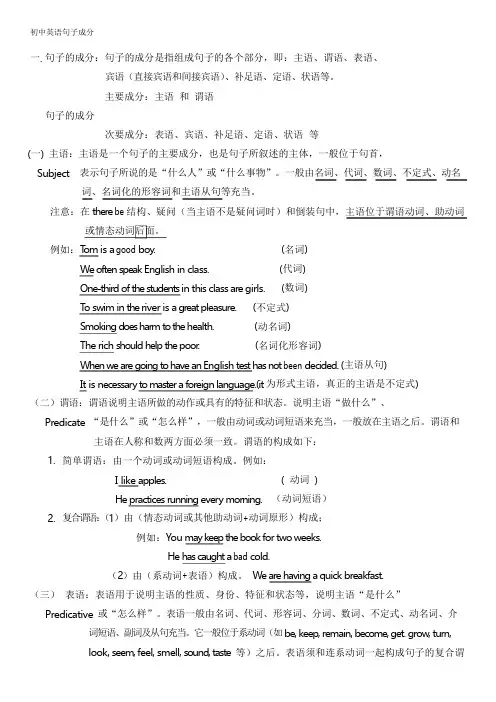
初中英语句子成分一.句子的成分:句子的成分是指组成句子的各个部分,即:主语、谓语、表语、宾语(直接宾语和间接宾语)、补足语、定语、状语等。
主要成分:主语和谓语句子的成分次要成分:表语、宾语、补足语、定语、状语等(一)主语:主语是一个句子的主要成分,也是句子所叙述的主体,一般位于句首,Subject表示句子所说的是“什么人”或“什么事物”。
一般由名词、代词、数词、不定式、动名词、名词化的形容词和主语从句等充当。
注意:在there be结构、疑问(当主语不是疑问词时)和倒装句中,主语位于谓语动词、助动词或情态动词后面。
例如:T om is a good boy.(名词)W e o ften speak English in class.(代词)One-third of the students in this class are girls.(数词)T o swim in the river is a gr eat pleasure.(不定式)Smoking do e s harm t o the health.(动名词)The rich should help the poor.(名词化形容词)When we are going to have an English test has no t been decided.(主语从句)It is necessary to master a foreign language.(it为形式主语,真正的主语是不定式)(二)谓语:谓语说明主语所做的动作或具有的特征和状态。
说明主语“做什么”、Predicate“是什么”或“怎么样”,一般由动词或动词短语来充当,一般放在主语之后。
谓语和主语在人称和数两方面必须一致。
谓语的构成如下:1.简单谓语:由一个动词或动词短语构成。
例如:I like apples.(动词)He practices running every morning.(动词短语)2.复合谓语:(1)由(情态动词或其他助动词+动词原形)构成;例如:Y ou may k eep the book for two weeks.He has caught a bad cold.(2)由(系动词+表语)构成。
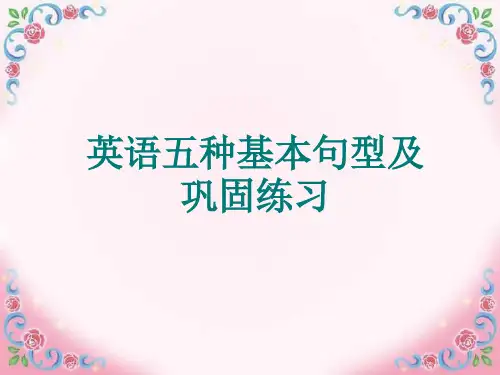
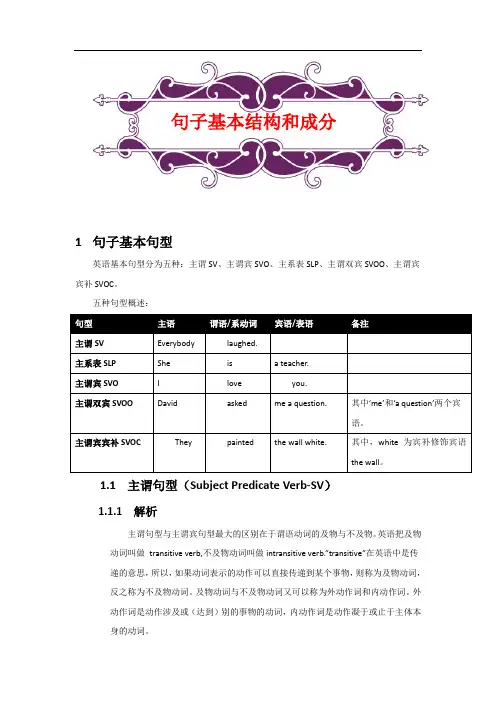
句子基本结构和成分1句子基本句型英语基本句型分为五种:主谓SV、主谓宾SVO、主系表SLP、主谓双宾SVOO、主谓宾宾补SVOC。
五种句型概述:句型主语谓语/系动词宾语/表语备注主谓SV Everybody laughed.主系表SLP She is a teacher.主谓宾SVO I love you.主谓双宾SVOO David asked me a question.其中‘me’和‘a question’两个宾语。
主谓宾宾补SVOC They painted the wall white.其中,white 为宾补修饰宾语the wall。
1.1主谓句型(Subject Predicate Verb-SV)1.1.1解析主谓句型与主谓宾句型最大的区别在于谓语动词的及物与不及物。
英语把及物动词叫做transitive verb,不及物动词叫做intransitive verb.”transitive”在英语中是传递的意思,所以,如果动词表示的动作可以直接传递到某个事物,则称为及物动词,反之称为不及物动词。
及物动词与不及物动词又可以称为外动作词和内动作词。
外动作词是动作涉及或(达到)别的事物的动词,内动作词是动作凝于或止于主体本身的动词。
1.1.2基本结构:主语+不及物动词1.1.3主语可以作主语的成分有名词(如boy),主格代词(如you),数词,动词不定式,动名词等。
主语一般在句首。
注意名词单数形式常和冠词不分家。
1.1.4谓语谓语由动词构成,是英语时态、语态变化的主角,一般在主语之后,后接宾语。
但谓语可以是不及物动词(vi.),没有宾语,形成主谓结构。
1.1.5例句分析:(1)The sun is rising. 太阳正在升起。
(2)Tim is sleeping. 蒂姆正在睡觉。
(3)The train is arriving.火车要到站了。
(4)We waited and waited. 我们等了又等。
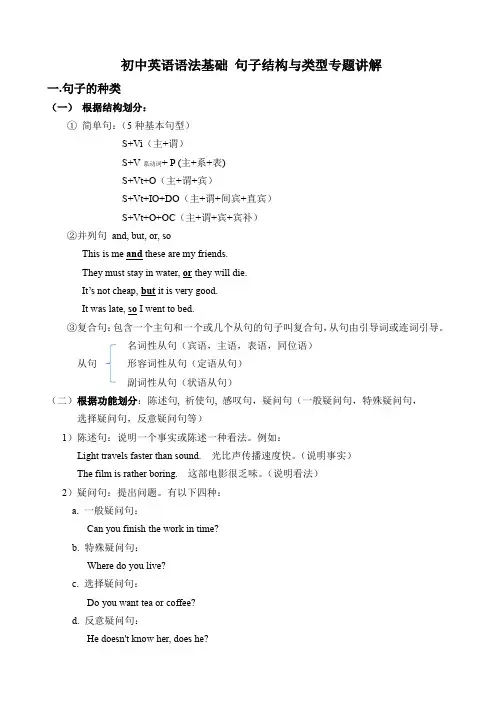
初中英语语法基础句子结构与类型专题讲解一.句子的种类(一)根据结构划分:①简单句:(5种基本句型)S+Vi(主+谓)S+V系动词+ P (主+系+表)S+Vt+O(主+谓+宾)S+Vt+IO+DO(主+谓+间宾+直宾)S+Vt+O+OC(主+谓+宾+宾补)②并列句and, but, or, soThis is me and these are my friends.They must stay in water, or they will die.It’s not cheap, but it is very good.It was late, so I went to bed.③复合句:包含一个主句和一个或几个从句的句子叫复合句,从句由引导词或连词引导。
名词性从句(宾语,主语,表语,同位语)从句形容词性从句(定语从句)副词性从句(状语从句)(二)根据功能划分:陈述句, 祈使句, 感叹句,疑问句(一般疑问句,特殊疑问句,选择疑问句,反意疑问句等)1)陈述句:说明一个事实或陈述一种看法。
例如:Light travels faster than sound.光比声传播速度快。
(说明事实)The film is rather boring.这部电影很乏味。
(说明看法)2)疑问句:提出问题。
有以下四种:a. 一般疑问句:Can you finish the work in time?b. 特殊疑问句:Where do you live?c. 选择疑问句:Do you want tea or coffee?d. 反意疑问句:He doesn't know her, does he?3)祈使句:提出请求,建议或发出命令。
Don't be nervous!Let’s go fishing tomorrow.4)感叹句:表示说话人惊奇、喜悦、愤怒等情绪。
What good news it is ! How beautiful the girl is !二.简单句的基本句型介绍:1. 基本句型一:S+Vi (主+不及物动词)主语:可以作主语的成分有名词,主格代词,动词不定式,动名词等等。
句子成分&五种基本句型一、考点、热点回顾I.【句子的成分】在英文中句子成分包括:主语、谓语、宾语(直接宾语、间接宾语)、表语、定语和状语、宾语补足语等。
(一)主语:主语是谓语讲述的对象,表示所说的“是什么”或“是谁”。
一般由名词、代词、不定式或相当于名词的词或短语来充当。
它在句首。
如:(1)Lucy is a beautiful nurse. (名词作主语)(2)He reads newspapers every day. (代词作主语)(3)Smoking is harmful to the health. (动名词作主语)(4)To swim in Kunming Lake is a great pleasure. (不定式作主语)(5)What we should do is not yet decided. (主语从句作主语)(二)谓语说明主语“做什么” “是什么”或“怎么样”。
谓语(谓语部分里主要的词)必须是动词。
谓语和主语在人称和数两方面必须一致。
它在主语后面。
女口:His parents are teachers. (系动词作谓语)We study hard. (行为动词作谓语)We don' t finish reading the book. (助动词和行为动词一起作谓语)He can speak En glish. (情态动词和行为动词一起作谓语)(三)宾语宾语是动作、行为的对象,由名词、代词、不定式或相当于名词的词、短语来担任,它和及物动词一起说明主语做什么。
一般放在谓语之后。
She is doing her homework now. (名词作宾语)She says (that)she is ill. (宾语从句作动词宾语)We ofte n help him. (代词作宾语He likes to play basketball. (不定式作宾语)We enjoy liste ning to the music. 我们喜欢听音乐。
五种基本句型与初中英语写作一、知识精讲五种基本句型是句子最基本的组成部分。
掌握了这五种基本句型,在阅读中当我们遇到较复杂的句子时,运用这些基本句型,对句子的分析就会变得容易多了。
在写作中,首先要能运用好这些基本句型,才能得到高分。
(一)五种基本句型的句子成分:1. 句子成分的定义:构成句子的各个部分叫做句子成分。
句子成分包括主要成分和次要成分;主要成分有主语和谓语;次要成分有表语、宾语、定语、状语、补足语等。
2. 主语(subject):主语是一个句子所叙述的主体,一般位于句首。
主语可由名词、代词、数词、不定式、动名词、名词化的形容词和主语从句等表示。
【例句】We often speak English in class我们在课上经常说英语。
Smoking does harm to the health. 吸烟对健康有害。
The rich should help the poor. 富有的人应该帮助贫困的人。
3.谓语(verb):谓语可用来说明主语所做的动作或具有的特征和状态。
动词常在句中作谓语,一般放在主语之后。
分及物动词和不及物动词两种。
【例句】He practices running every morning.他每天早晨练习跑步。
I have caught a bad cold. 我得了重感冒。
We like helping the people in trouble我们喜欢帮助那些处于困境中的人。
4. 宾语(object):宾语在句中表示动作的对象或承受者,一般位于及物动词或介词后面。
【例句】They went to see a film yesterday.他们昨天看了一场电影。
She often helps her mother with their housework.她经常帮助她的妈妈做家务。
I enjoy listening to popular music. 我喜欢听流行音乐。
句子成分及基本句型一、考点、热点回顾【句子的成分】在英文中句子成分包括:主语、谓语、宾语(直接宾语、间接宾语)、表语、定语和状语、宾语补足语等。
(一)主语:主语是谓语讲述的对象,表示所说的“是什么”或“是谁”。
一般由名词、代词、不定式或相当于名词的词或短语来充当。
它在句首。
如:(1)Lucy is a beautiful nurse. (名词作主语)(2)He reads newspapers every day. (代词作主语)(3)Smoking is harmful to the health. (动名词作主语)(4)To swim in Kunming Lake is a great pleasure.(不定式作主语)(5)What we should do is not yet decided. (主语从句作主语)(二)谓语:说明主语“做什么”“是什么”或“怎么样”谓语和主语在人称和数两方面必须一致。
它在主语后面。
如:His parents are teachers. (系动词和表语一起作谓语)We study hard. (行为动词作谓语)We don’t finish reading the book. (助动词和行为动词一起作谓语)He can speak English. (情态动词和行为动词一起作谓语)(三)宾语:宾语是动作、行为的对象,由名词、代词、不定式或相当于名词的词、短语来担任,它和及物动词一起说明主语做什么。
一般放在谓语之后。
She is doing her homework now.(名词作宾语)She says(that)she is ill.(宾语从句作动词宾语)We often help him.(代词作宾语)He likes to play basketball.(不定式作宾语)We enjoy listening to the music. 我们喜欢听音乐。
腾训学校语法班---句子成分及基本句型【句子的成分】在英文中句子成分包括:主语、谓语、宾语(直接宾语、间接宾语)、表语、定语和状语、宾语补足语等。
(一)主语:主语是谓语讲述的对象,表示所说的“是什么”或“是谁”。
一般由名词、代词、不定式或相当于名词的词或短语来充当。
它在句首。
如:(1)Lucy is a beautiful nurse. (名词作主语)(2)He reads newspapers every day. (代词作主语)(3)Smoking is harmful to the health. (动名词作主语)(4)To swim in Kunming Lake is a great pleasure.(不定式作主语)(5)What we should do is not yet decided. (主语从句作主语)(二)谓语说明主语“做什么”“是什么”或“怎么样”。
谓语(谓语部分里主要的词)必须是动词。
谓语和主语在人称和数两方面必须一致。
它在主语后面。
如:His parents are teachers. (系动词和表语一起作谓语)We study hard. (行为动词作谓语)We don’t finish reading the book. (助动词和行为动词一起作谓语)He can speak English. (情态动词和行为动词一起作谓语)(三)宾语宾语是动作、行为的对象,由名词、代词、不定式或相当于名词的词、短语来担任,它和及物动词一起说明主语做什么。
一般放在谓语之后。
She is doing her homework now.(名词作宾语)She says(that)she is ill.(宾语从句作动词宾语)We often help him.(代词作宾语)He likes to play basketball.(不定式作宾语)We enjoy listening to the music. 我们喜欢听音乐。
简单句考试要求:简单句的五种基本句型及There be句型是英语学习的基础和重点,也是中考试卷的重点,在书面表达、句子改写和翻译句子中都经常考查有关句子的知识;感叹句、疑问句、祈使句更是单项选择和句型转换的重点。
1.简单句的句型简单句就是句子只有一个主语和谓语,有五种基本句型:(1)主语+谓语:这种句型称为主谓结构(S+V),其谓语一般是不及物动词。
例如:The rain stopped. 雨停了。
Things have changed now. 现在事情发生了变化。
(2)主语+连系动词+表语:这种句型称为主系表结构(S+L+P),连系动词在形式上也是一种谓语动词,表语一般是名词或者形容词。
例如:His father is a teacher. 他的爸爸是老师。
(表语是名词)Your mother is very young. 你的妈妈很年轻。
(表语是形容词)(3)主语+谓语+宾语:这种句型称为主谓宾结构(S+V+O),其谓语动词是及物动词,宾语一般是直接宾语。
例如:They often speak English at the meeting. 他们在会上经常说英语。
The house caught fire. 房子着火了。
(4)主语+谓语+间接宾语+直接宾语:这种句型称为主谓宾宾结构(S+V+O+O),其谓语动词必须是可以跟双宾语的动词,两个宾语中表示事物的是直接宾语,另一个表示人的是间接宾语。
例如:My father gave me a pen last night. 昨天晚上我爸爸给我一支钢笔。
I will write you a letter when I get there. 我到那里儿时给你写信。
(5) 主语+谓语+宾语+宾语补足语:这种句型称为主谓宾及宾补结构(S+V+O+C)其谓语动词必须是可以跟复合宾语的及物动词。
例如:I find him very clever. 我发现他很聪明。
初中英语五种基本句型结构总结(附例题解析)一、知识精讲五种基本句型是句子最基本的组成部分。
掌握了这五种基本句型,在阅读中当我们遇到较复杂的句子时,运用这些基本句型,对句子的分析就会变得容易多了。
在写作中,首先要能运用好这些基本句型,才能得到高分。
(一)五种基本句型的句子成分:1. 句子成分的定义:构成句子的各个部分叫做句子成分。
句子成分包括主要成分和次要成分;主要成分有主语和谓语;次要成分有表语、宾语、定语、状语、补足语等。
2. 主语(subject):主语是一个句子所叙述的主体,一般位于句首。
主语可由名词、代词、数词、不定式、动名词、名词化的形容词和主语从句等表示。
【例句】We often speak English in class.我们在课上经常说英语。
Smoking does harm to the health.吸烟对健康有害。
The rich should help the poor.富有的人应该帮助贫困的人。
3. 谓语(verb):谓语可用来说明主语所做的动作或具有的特征和状态。
动词常在句中作谓语,一般放在主语之后。
分及物动词和不及物动词两种。
【例句】He practices running every morning.他每天早晨练习跑步。
I have caught a bad cold.我得了重感冒。
We like helping the people in trouble我们喜欢帮助那些处于困境中的人。
4. 宾语(object):宾语在句中表示动作的对象或承受者,一般位于及物动词或介词后面。
【例句】They went to see a film yesterday.他们昨天看了一场电影。
She often helps her mother with their housework.她经常帮助她的妈妈做家务。
I enjoy listening to popular music.我喜欢听流行音乐。
句子成分&五种基本句型一、考点、热点回顾I.【句子的成分】在英文中句子成分包括:主语、谓语、宾语(直接宾语、间接宾语)、表语、定语和状语、宾语补足语等。
(一)主语:主语是谓语讲述的对象,表示所说的“是什么”或“是谁”。
一般由名词、代词、不定式或相当于名词的词或短语来充当。
它在句首。
如:(1)Lucy is a beautiful nurse. (名词作主语)(2)He reads newspapers every day. (代词作主语)(3)Smoking is harmful to the health. (动名词作主语)(4)To swim in Kunming Lake is a great pleasure.(不定式作主语)(5)What we should do is not yet decided. (主语从句作主语)(二)谓语说明主语“做什么”“是什么”或“怎么样”。
谓语(谓语部分里主要的词)必须是动词。
谓语和主语在人称和数两方面必须一致。
它在主语后面。
如:His parents are teachers. (系动词作谓语)We study hard. (行为动词作谓语)We don’t finish reading the book. (助动词和行为动词一起作谓语)He can speak English. (情态动词和行为动词一起作谓语)(三)宾语宾语是动作、行为的对象,由名词、代词、不定式或相当于名词的词、短语来担任,它和及物动词一起说明主语做什么。
一般放在谓语之后。
She is doing her homework now.(名词作宾语)She says(that)she is ill.(宾语从句作动词宾语)We often help him.(代词作宾语)He likes to play basketball.(不定式作宾语)We enjoy listening to the music. 我们喜欢听音乐。
(动名词短语作宾语)说明1:宾语是及物动词涉及到的人或物,宾语一般放在及物动词之后。
介词后面的名词或代词或动名词,称为介词宾语。
名词、代词、数词常在句中做动词宾语或介词宾语。
另外,动词不定式可作动词宾语;动名词和宾语从句也可用作动词宾语。
说明2:及物动词作谓语时,后面要跟宾语。
宾语分直接宾语和间接宾语。
直接宾语是及物动词的直接对象,直接宾语指物,间接宾语通常是及物动词的动作所及的人,间接宾语指人。
间接宾语一般放在直接宾语之前。
不是所有的及物动词都可以用双宾语。
有的动词可以跟。
如:give, show(给……看),bring, pass, buy等。
如:(1)Our teacher tells us a story.(2)The sun gives us light.间接宾语如果放在直接宾语之后,在表示“人”的间接宾语之前会出现介词“to”或“for”。
★间接宾语前加“to”的有:give, show, send, bring, read, pass, lend, leave, hand, tell, return, write, throw, promise(答应), refuse(拒绝)等。
★间接宾语加“for”的有:make, buy, do, get, play, order(命令), sing, pay等(1)I give him a book. 改成:(2)He passes me the book.(他将书递给我。
)改成:(3)He writes me a letter. 改成:(4)He will buy me some books. 改成:(5)She is making me a cake. 改成:(四)宾语补足语在宾语后面补充说明宾语的动作、状态、特征的成分,称为宾语补足语。
名词、形容词、副词、介词短语以及动词不定式、分词等可用作宾语补足语。
宾语和宾语补足语称为复合宾语。
如:They make her happy.(形容词)I see her dance.(省to的不定式)We’ll help you to make the Olympics a success.(名词)Please let him in.(副词)We heard her singing a song.(分词短语)(五)表语表语说明主语“是什么”或者“怎么样”,由名词、形容词、副词、介词、不定式及名词或形容词短语来担任。
它的位置在系动词后面。
如:I am a teacher.(名词)He is always happy.(形容词)They are on the playground now.(介词短语)It gets cold.(形容词)Be动词(am,is,are, was, were)系动词表保持(keep, stay, remain)表改变(get,become,turn)感官动词(feel,sound(听起来),seem/look(看起来),taste(尝起来),smell(闻起来))如:It sounds interesting.(sound为系动词,interesting为表语)We should all remain careful. (Remain为系动词,careful为表语)(六)定语定语是用来修饰名词或代词的。
形容词、代词、数词、名词、介词短语、不等式或相当于形容词的词或短语等。
单个词作定语时,通常放在它所修饰的名词之前。
如:The black bike is mine.(形容词)What’s your name?(代词)They make paper flowers.(名词)说明1:当定语修饰不定代词:nothing, anything, everything, something等时,定语在不定代词后面。
如:I tell him something interesting. (形容词interesting作不定代词something的后置定语)He has something to do. (to do为不定式作后置定语)说明2:短语或从句作定语时,也放在被修饰的名词之后。
如:The boys in the room are in Class Four. (in the room是介词短语作the boys的后置定语。
)(七)状语修饰动词、形容词、副词。
一般表示行为发生的时间、地点、目的、方式、程度等意义,一般由副词、介词短语、不定式或相当于副词的词或短语来表示。
状语一般放在句末,但有的可以放在句首、句中。
如:He did it carefully.(副词)We often help him.(副词)Her mother goes out to do some shopping on Sunday.(介词短语)When I grow up, I am going to be a teacher.(从句作时间状语)He sits there.(副词地点状语)II. 【五种基本句型】A. 主语+不及物动词(主谓)如:The sun rises. 太阳升起来。
The car stopped. 小汽车停下来了。
rise和stop都是不及物动词,因此后边不必加宾语。
B. 主语+及物动词+宾语(主谓宾)如:I love my country.He helps me.I like action movies.I buy a book.C. 主语+系动词+表语(主系表)如:Her brother is a driver.We feel happy.(feel为系动词,表示感到……)It gets dark.天黑了。
(get为系动词,表示变得)Tom looks ill. Tom看上去病了。
(look为系动词,表示看上去,看起来)D. 主语+及物动词+双宾语(直接宾语、间接宾语)(主谓+直宾+间宾)如:He gives Tom a present.(双宾语)他给汤姆一件礼物。
Mother make a new dress for me.(双宾语)妈妈为我做了一件衣服。
E. 主语+及物动词+宾语+宾语补足语(主+谓+宾+宾补)如:They call her Mary.(宾补)他们叫她Mary。
We make our classroom clean and tidy.(宾补)我们使我们的教室干净而整齐。
He always makes us laugh.(宾补)他总使我们笑。
二、典型例题写出划线部分的句子成分。
1. Lily is cleaning the desk now.2. Her garden is the best in our town.3. Liu Ming is thirteen years old.4. I like this book very much.5. The girl on the blue bike is Jane’s sister.6. She didn’t come to my party because she was ill.7. Wang Ping does his homework carefully.8. We will go to the Children’s Palace once a week.9. They are in the classroom.10. It sounds good.11. His name is Paul.12. We always go to school early.三、课后练习(一) 挑出下列句中的宾语① My brother doesn't do his homework.A B C D② People all over the world speak English.A B C D③You must pay good attention to your pronunciation.A B C D④How many new words do you learn ?A B C D⑤Some students in the school want to go swimming, how about you?A B C D(二) 挑出下列句中的表语① The old man is feeling very tired.A B C D②Why is he worried about Jim?A B C D③ The leaves have turned yellow.A B C D④Soon They all become interested in the subject.A B C D⑤She is the first to learn about it.A B C D(三) 挑出下列句中的定语① They use Mr. Mrs. with the family name.A B C D② What is your given name?A B C D③On the third lap are Class 1 and Class 3.A B C D④I am afraid some people forgot to sweep the floor.A B C D⑤ The man downstairs was trying to sleep.A B C D(四) 挑出下列句中的宾语补足语①She likes the children to read newspapers & books in the reading-room.A B C D②He asks her to take the boy out of school.A B C D③She find it difficult to do the work.A B C D④They call me Lily sometimes.A B C D⑤ I saw Mr. Wang get on the bus.A B C D(五) 挑出下列句中的状语① There is a big smile on her face.A B C D② Every night he heard the noise upstairs.A B C D③He began to learn English when he was eleven.A B C D④ The man on the motorbike is travelling to fast.A B C D⑤ With the medicine box under her arm, Miss Li hurried off.A B C D(六) 划出句中的直接宾语( )和间接宾语()①Please tell us a story.②My father bought a new bike for me last week.③Mr. Li is going to teach us history next term.④Here is a pen. Give it to Tom.⑤Does he leave any message for me?(七)写出下列句子的结构1. They work hard. ______________2. The flowers are dead. ____________3. Plants need water. ______________4. He gave me some seeds. ___________5. We should keep the plant in the shade. ____________6. Many animals live in trees. _________7. The cake tastes delicious. __________8. Class begins at eight every day. _____。